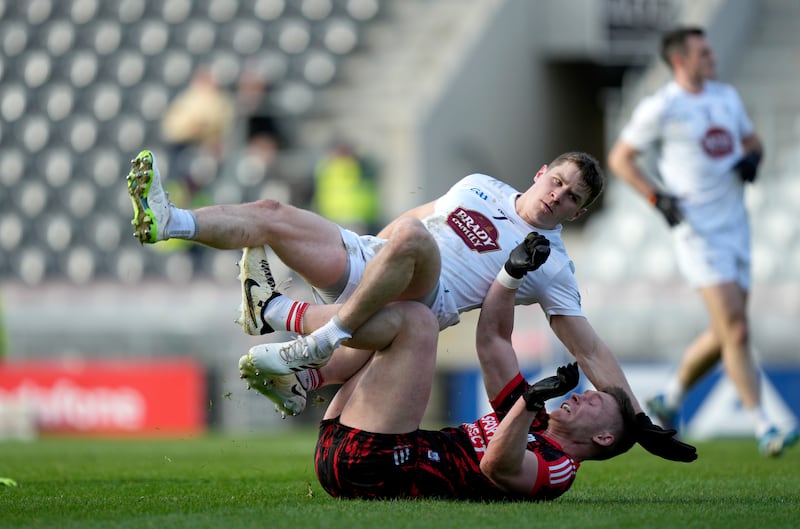Former GAA director general Liam Mulvihill used to lament the peculiarities of the national leagues and their routines. How they would open to high levels of enthusiasm and yet conclude in near indifference by the time the finals were played – as if this was some mathematical conundrum with a solution that could be worked out and applied.
The truth, then and now, is that the shadow of championship falls on the closing stages of the league. In fact, these days it is not even a shadow as within a week of the league final, the provincial championships are on top of us all, including two Division One counties.
It might not be as drastic a step change as when Mayo emerged with the title last year only to lose to Roscommon in Connacht a week later, but it is an abrupt reordering of priorities for all concerned, both teams and spectators.
This undoubtedly contributes to the rush to put the league behind us, but it has never been much different.
‘A lot of hurt in the team’: Pain of defeat pushes Kilkerrin-Clonberne’s drive for five
Karen Dessain-Gelinet named new CEO of Camogie Association
All-Ireland club final: St Ergnat’s take inspiration from Tony McCoy ahead of last hurdle
Ciarán Murphy: Thrilling club final highlighted the best and downright worst of new rules
Circumstances have not helped this year either. For a long time, there was big interest in the final day of the season and who would be going up or dropping down, probably to a greater extent than what counties would contest the finals.
Next weekend lacks that broad sense of jeopardy and things being on the line. In all likelihood, we know the Division One finalists. Dublin could lose to Tyrone and Derry might be beaten by Roscommon but these two away wins would cumulatively fetch you 16-1.
Even relegation has been partly decided. Monaghan have not been able to take their survival struggle to the last day of the league, as happened so frequently in recent times and unless Roscommon upset the above odds, they will be joining them.
In the absence of fortunes fluctuating up and down on Sunday afternoon, it becomes just another fixtures schedule.
Of course, the past two years have conferred on the league a direct relevance to the championship but that issue of Sam Maguire status revolves around the bottom of Division Two and the top of Division Three.
The top three teams in this year’s league are virtually certain to be Derry, Dublin and Kerry, also the top three counties in the betting for the All-Ireland
Even then, it is an uncertain awards system. Last year’s finalists in Division Three both missed out because Westmeath, who finished below them, were Tailteann Cup holders and so entitled to contest the higher championship – at the expense of Fermanagh, runners-up in the division.
The draw in Connacht had already ensured that a non-top 16 county – Sligo as it turned out – would be seeded as provincial finalists, which took care of Cavan as well.
This year, if Clare do not get promoted, there will be another side of a provincial draw, this time in Munster, coming from outside the top two league divisions, which will eliminate the Division Three runners-up. Should Kildare, on the non-Dublin side of the Leinster draw, gather themselves after relegation – as they could well do, starting this Saturday against Louth – they would deprive the Division Three winners of Sam Maguire participation.
Two years in, the new system could end up not having facilitated any of the four promoted Division Three counties in playing for the Sam Maguire. Further, it could mean that two of the four teams relegated, Clare last year and Kildare this time around, winning their way out of the Tailteann Cup – like buying your way out of a commission.

If the much-trumpeted 38th parallel between Maguire and Tailteann is turning out to be less than strictly observed, what about motivation further up the league?
There is no point in reheating the potential dangers of winning the league if championship is following too quickly. But the benefits are widely appreciated.
The close connection between winning the league and later the championship has not continued to be as strong as it used to be, but there remains a clear correlation between success in one and then the other.
Eleven times in the past 20 years, the All-Ireland winners have previously been at least league finalists and with three exceptions, at least one of them has reached the All-Ireland semi-finals.
That two of the three exceptions happened in the past four years could be taken as evidence of a loosening connection, but one happened in the winter championship of 2020 when Kerry, surprised by Cork, had no second chance because of the suspension of the qualifiers during Covid.
The overall trend will in all likelihood resume this year. The top three teams in this year’s league are virtually certain to be Derry, Dublin and Kerry, also the top three counties in the betting for the All-Ireland.
Derry have been the most consistent side to date and under Mickey Harte are targeting a first win in Croke Park over one of their peers, an opportunity which is likely to present itself at the end of the month.
Dublin are having their best league in six years, the swift nature of their attacking play a break from the more ponderous routines of recent times. Three of their first four points within the opening 10 minutes against Galway were achieved from possessions of 15, 16 and 19 seconds.
For the first of these, Evan Comerford’s kick-out to Seán Bugler was on the button and two passes later, the ball was over the bar.
Kerry, although unlikely to make the final, have also looked impressive. They secured a comfortable win on the road in Roscommon despite the home side’s dire need for points. They are processing the big defeat by Dublin, although manager Jack O’Connor was quick to deny they were over it.
Any way you look at the snapshot of the current Division One, it looks like it will be a familiar picture by the end of July.

















